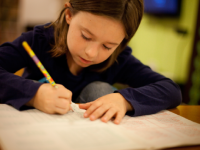Equity in Education: Where to Begin?
If we hope for equity in education, we may have to abandon our efforts toward standardization and recognize the individuality of our students.
In a profession increasingly full of angst and positioning and corrective policy, there are few ideas as easy to get behind as equity.
Equal. Equality. Equity. Equilibrium. Equate. These are all fine ideas -- each tidy and whole, implying its own kind of justice while connoting the precision of mathematics. Level. Same. Twin. Each word has its own nuance, but one characteristic they share is access -- a level, shared area with open pathways that are equidistant to mutually agreed-upon currencies.
When discussing equity, there are so many convenient handles -- race, gender, language, poverty, access to technology -- but there may be a larger view that we're missing.
The Scale of Equity
There isn't a more global issue, equity being perhaps the global issue of our time. According to United Nation statistics published last year in The Economist:
This is a starkly different conversation about equity than the one we might have in the U.S., U.K., Canada, or Australia. We have the luxury of becoming choosier, and harsher on ourselves, as progress is made. In other words, let's first make sure there are free, quality schools everywhere, and that children can all read and write, and later we can concern ourselves with iPads vs. Androids, or the broadband access in our poorest communities.
It’s easy to miss the scale of equity as an "issue," because unlike assessment, curriculum, teacher pay, class sizes, educational technology, or any other persistently evergreen edu-choke point, equity never stops affecting. It's both the center and periphery of everything because we're always who we are and where we are.
The Cultural Effect
As a species, we express ourselves through difference. What makes "culture" interesting is how it both recognizes the individual and simultaneously allows individuals to disappear into the whole again -- identity and anonymity. There is a constant self-to-group transaction based on both affection (inward expression) and image (outward expression). This transaction is then repeated across cultures, with completely different functions. Differences within and across cultures are differences nonetheless, but the individual can think while groups simply gather.
So this is a brutally narrow take on how people gather, cohort, and manifest their vision of what it means to be human, but the point remains: As educators, we suffer that same reductionism when we see the masses in the same way that Nielsen does television ratings. Students aren't demographics, and it’s murky at best to see how treating them that way has improved their lot, or our shared progress.
While squinting and trying to narrow gaps, it's easy to lose the scale and product of our work. The segmenting of individual students into a group, and that group into a subgroup, and their understanding into data, and the knowledge that we hope they learn into our teaching standards -- this all becomes a tone, a posture dictating the terms of teaching and learning. Equity in the classroom is different than in the job market.
A sub-corollary is that we all share equity and inequity, both in possession and effect. In The Hidden Wound, Wendell Berry writes:
This is both abstract and practical. We share both living space and social membership.
The Puzzle of Individuality
Somehow, more so than any other industry or profession, public education is expected to aggregate these inherent disparities while transcending them. Our task?
- Create a curriculum that provides a common language for knowledge without homogenizing the nuance of that knowledge.
- Design learning models that are inherently inclusive regardless of access to technology.
- Establish authentic functions for family members and communities who may speak a completely different language.
As individuals, we work to separate ourselves -- as children, often based on image; and as adults, often based on income, where we choose to live, what we drive, the smartphone we carry, and what we do "for a living." But each expression of self -- gender, native language, race, sexuality, socioeconomic level, and so many others -- is also an opportunity for disparity that works to undermine the function of education.
It's easy to see equity in education as a matter of fairness, access, and inclusion, but that's only the case if what's being fairly accessed is a system of teaching and learning that's fluid, responsive, dynamic, neutral, alive, and able to meet the needs of an increasingly global population. For an industry struggling to get every student reading on grade level, this may be a bit much. My gut reaction is that this can only occur through the affectionate expression of the local -- this student in this home in this community, with the school functioning as an extraordinary support system.
Rebuilding From the Basement
The equity is at the student level rather than the demographic level because demographics only exist on paper. Every student experiences commonality and difference -- what's shared (a student needing knowledge) and what's distinct (urban, rural, white, black, male, female). This never stops. We can revise our schools, curriculum, pedagogy, and technology until it's inclusive, fair, and accessible to every student, but that ongoing effort continues to represent a kind of basement for our goals.
Why not consider something more ambitious? New thinking about the terms and definitions of gender emphasize both the characteristics and the fluidity of any culture. If we insist on standardizing content, maybe we can avoid standardizing education. How many different answers are there to the question, "Why learn?" Fantastic! Let's iterate ourselves until we can honor that.
The work before us, then, may not be to level an academic playing field for which there is no even, but rather to create new terms for why we learn, how, and where -- and then change the expectation for what we do with what we know.
